Discovering a Character by Drawing
This week is about illustrating characters and discovering those that feel personal.

Have you ever wanted to draw a face or a figure that would really touch your heart? I don’t only mean something that looks pretty on paper but someone that begins to speak to you when your eyes meet.
Starting from an Animal Figure
In the class Magical Inkdom, I mention the word “kissanukke” when we are drawing cats. Kissanukke is “cat doll” in English, but somehow I think it’s much funnier in Finnish. Say: kissanukke! The word is just hilarious.
Last week, I wondered why I think about that word so often. Maybe it’s a hint I should draw cats again. So, I picked a big smooth watercolor paper and a pencil to sketch a huge cat. I wanted to go big because I wanted the cat’s face to be large enough for working on facial features. I adjusted them for a long time with a pencil, and then with colored pencils. I wanted this kissanukke to be more than a doll – a living thing that speaks to me.

I love to use thick and smooth watercolor paper with colored pencils even when I don’t use water for the drawing.
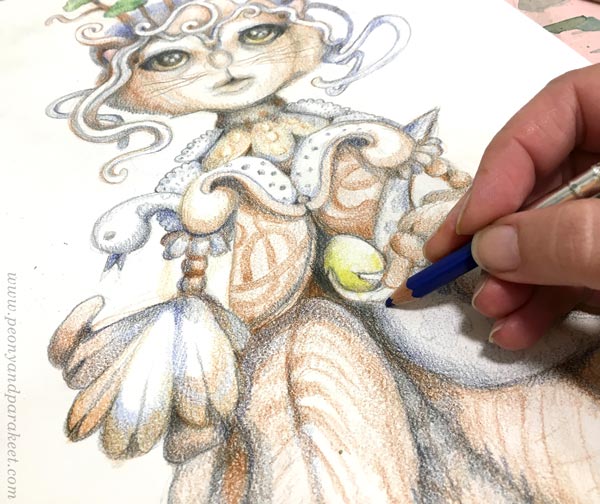
When the paper is big, it’s easy to dive deep into details and let them make the drawing more whimsical than the original sketch.
What’s Behind the Animal?
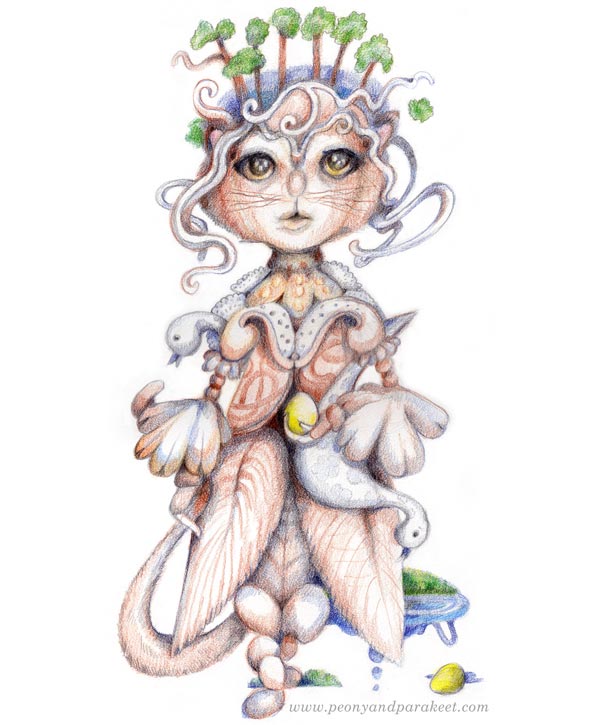
When Kissanukke was born, I asked her: “Who are you?” She said: “I am a hunter, and I can bring you anything you want!” I smiled at her: “What a magical cat you are, with the golden egg and all!” “I had two,” she said, “but the other one got missing when I tried to catch the geese. And I am no cat but a lion!”
Of course, she is a lion – how did I not see that before! I used to be a big fan of Joy Adamson and her lion Elsa as a child. No wonder my inner child has kept asking for cats!
Discovering Through a Different Pose
So, I thought, let’s draw another leijonanukke – lion doll – for the child. This time, I changed the pose so that the character would only need to glance sideways and wished that a shyer creature would appear.
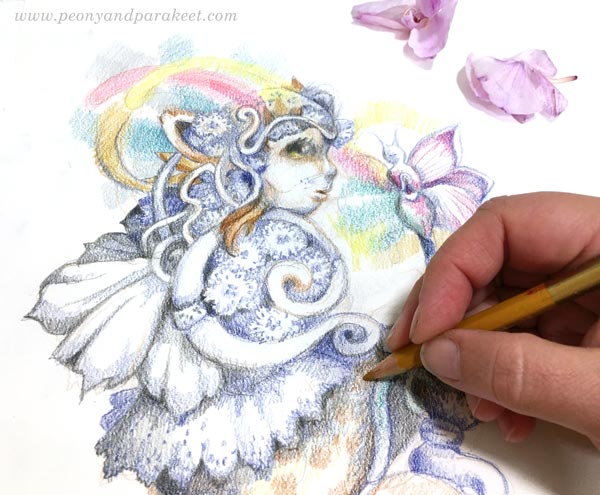
“Are you a hunter too?” I asked when discovering the new character. “No, I am an orchid whisperer! Shhh!”
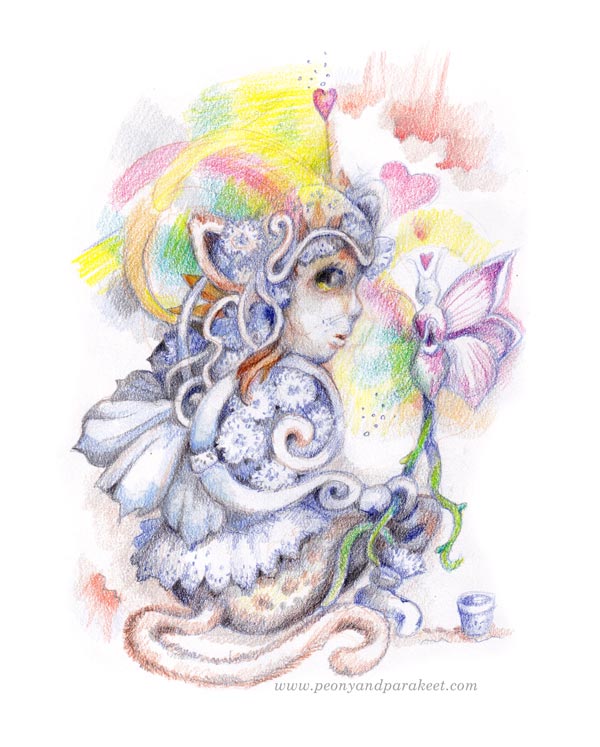
One of my orchids just stopped blooming, and I am eagerly waiting another to bloom. So, there’s a need for her too!
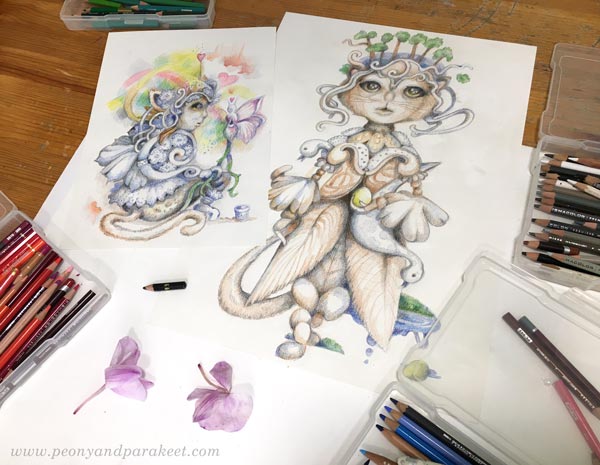
Whisperer is smaller than Hunter. The small size also makes her look less finished in the pics. If you need to provide a hand drawing in a digital form, always draw larger than the asked size. The result looks neater that way.
Discovering a Human Character
This week, I went to the studio and gathered all the courage I got. “Hunter,” I said, “could you bring me a human that really touches my heart.”
And that’s how this little country girl came out – a true nature child!
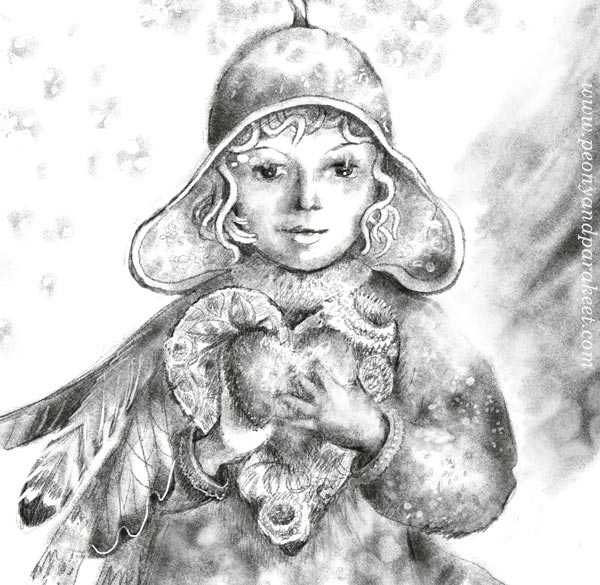
I didn’t use any references when drawing the girl and the cats. A reference can help us draw what’s expected but not what comes out naturally. References are great practice, and during the years, I have been practicing with them too. For example, in the class Innovative Portraits, we draw faces and use references creatively. But when discovering a character that feels like a soul mate, references become disturbing. Then it’s all about the connection with your inner self, traveling back in time for inspiration and forward in imagination.
Digital Pencil Work
I drew the girl on my iPad with Apple Pencil and the program called Procreate. I got these fancy tools as a birthday gift from my husband in February but have been waiting for the right moment to get to know them.
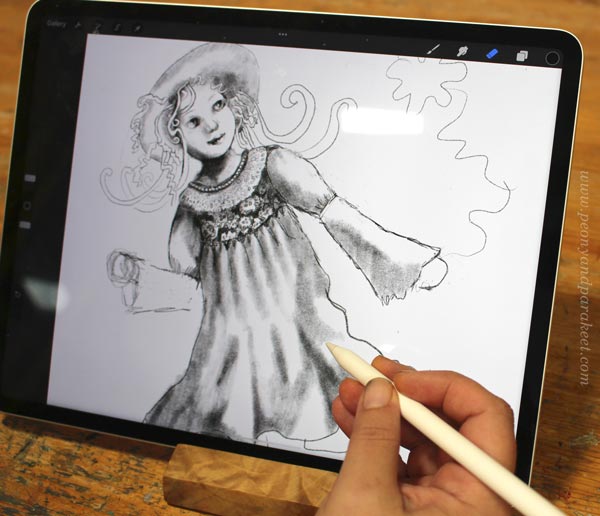
So far, I have mostly been using a simple digital brush called “Peppermint” that imitates a graphite pencil.
I will blog more about Procreate later, so it would be interesting to hear if you have used it. Also, if you have any questions, please let me know! However, if you are not into digital tools, don’t worry, I will keep on drawing with real pencils too!
Adventurous Art is Like an Action Movie
This week, I show you my newest painting and talk about the adventurous side of art.
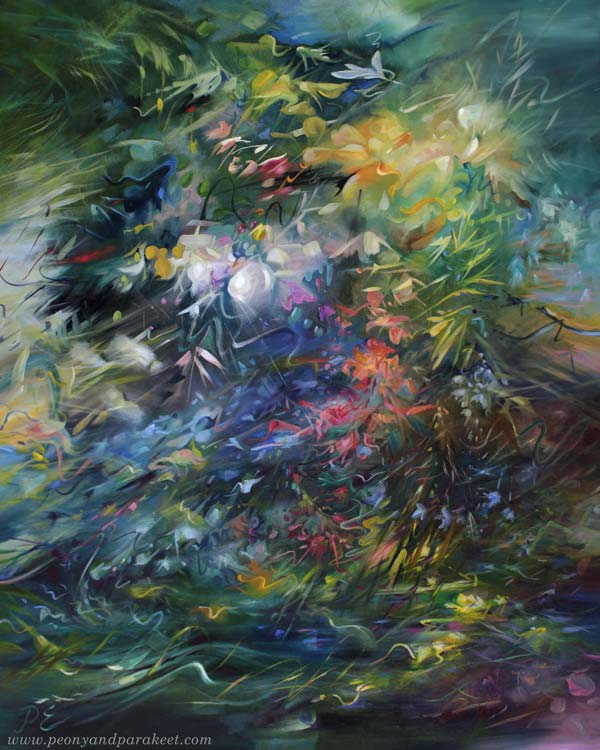
I am not a big fan of action movies. I love their beginnings when the sun shines, and everything is fine but leave the sofa when something terrible happens. Then things get out of control, cars get faster than they should be, people lose their relaxed look, and the life that appeared so organized first falls apart. Some fly up towards the darkness while others fall down. Nothing is like it should be. Everything requires movement and action in that disturbed world.
However, when I paint, I always end up in an action movie. So for me, a painting can only start by facing fears. It’s like carefully opening the curtain and trying to adjust the mind to tolerate the rough surroundings first, then find the beauty and spirit in them.
Facing the Fears – Starting a Painting
For years I searched for my artistic voice from things I loved. But ironically, I found my tone in the things that feel appalling. So, like a young man who sits down and picks the next action movie from Netflix, I go to my studio, fill the palette and hear the opening notes.

Unlike the man, I have never wanted to be an action hero, and still, I sail against the storm with only a few brushes as my companion. Before the first high point of the movie, the man thinks he should do something different, clean the dishes, or read a good book. And similarly, I question if this profession of mine is sensible at all. After all, it’s only the paint that I maneuver when the others keep the world going.
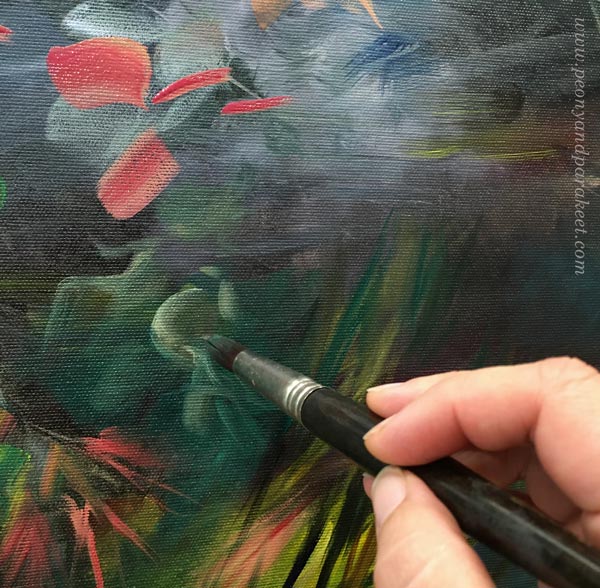
But then, like the man, I get immersed in the adventure. He is no longer a young bloke without the skills of an action hero, and similarly, I am no longer a middle-aged woman. There’s this dangerous jungle, and we are on a mission to clear the mess and make justice.
Telling the Story Under the Surface
Like in an action movie, the violent and cold setting hides another layer – vulnerability. The story behind an action hero is always heart-breaking. He has lost or left a loved one or protects someone he values.

At best, the painting is not only full of action but brings up what’s behind the sharp strokes.
Dealing with Distractions
Just when the movie reaches the climax, something mundane happens.

The young man’s phone rings, the washing machine peeps, or the dog wants to go out. “Just when everything began to unfold!” I shout with him.

But sooner or later, we return to the movie, enjoy the freedom, and finally reach the happy ending. When the adventure is over, our minds are a bit empty, but that is what action movies do. They take you to another place and reset your mind.
Creating Adventurous Art is About Producing Too
Being a painter is still a little different. Instead of only passively watching, you are also actively creating. While enjoying the freedom, you also produce it. You design the environment, act on all the roles, and direct the plot. It takes time to learn all that.

However, I feel that the best adventures are revealed by painting.
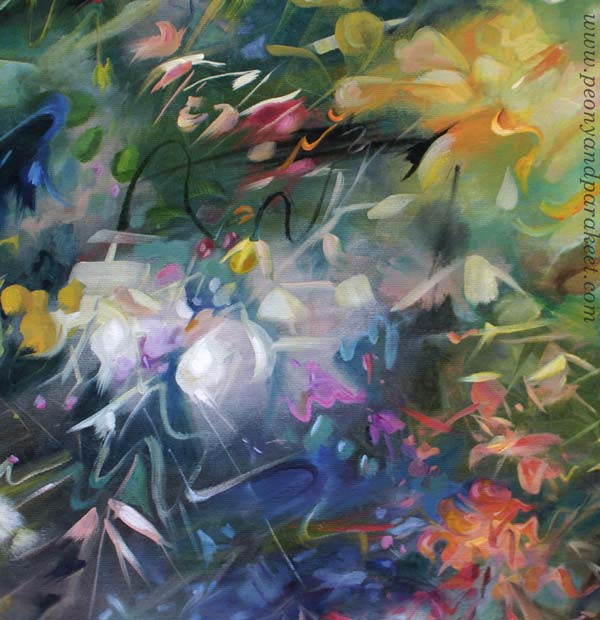
When flowers can then be the actors, not just silent models, a flower painting is far from boring.

What do you think? What does adventurous art mean to you?
Angel Drawing for the Inner Child
As a child, I had a collection of scrap reliefs – small pictures printed and cut from glossy paper. A very common one was a simple angel with a head between wings. This week, I created my version of an angel drawing.

This is only a small piece on smooth watercolor paper, but the child in me likes it a lot!
My Approach to Drawing and Painting
My desire for art can be summed up in two parts. The first part is to go on an adventure by painting freely.

When I paint, I feel that it’s the only thing that I want to do and where I am good at.
But then, after washing the brushes, comes the second part. A child in me evokes and says: “Draw to me!” Like I often said to my father or to my sisters when I was only a few years old. The child doesn’t require much: “Something pretty!” (Watch a video about my inner child!)
Child’s Enthusiasm in Angel Drawing
I used to adore whatever my father or sisters drew. Now, similarly, I feel the acceptance of the child right from the beginning. No matter how I struggle with any detail, the child’s enthusiasm keeps me drawing.
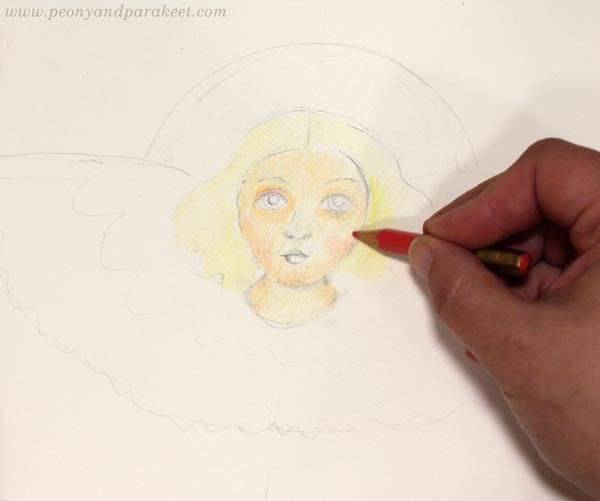
And even if I had just thought that I should only paint and do nothing else, drawing a small ornament feels as natural and enjoyable. The same creative stream seems to feed both parts of my artistic expression.

A simple sketch gets more ideas when I start adding details. Coloring a halo with yellow feels boring, so I draw clouds, then a rainbow. An unwritten story begins to flow into the image.
Small Tweaks to a Simple Sketch Make the Angel Drawing
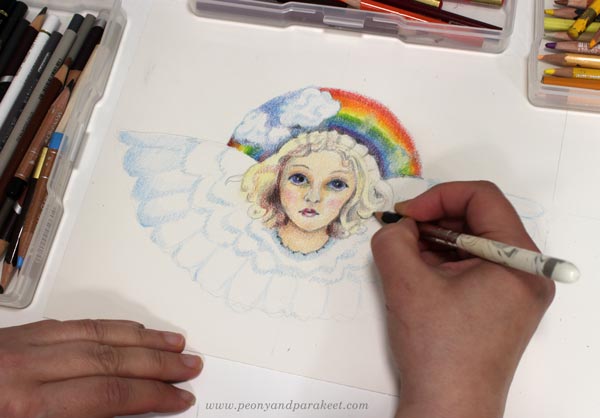
Simple shapes become more interesting when I keep drawing. Quick and simple wings get more decoration, and small adjustments to the face and hair add up.
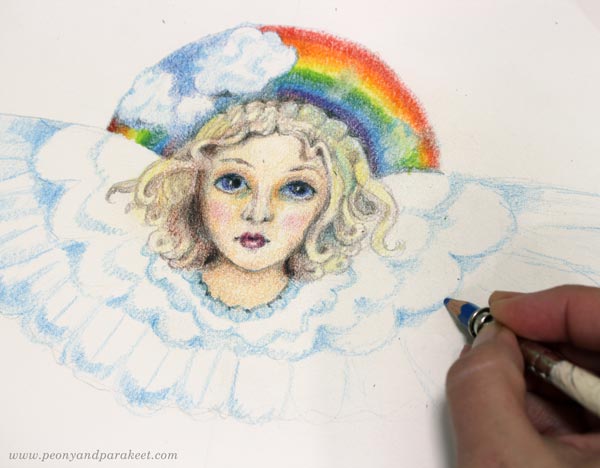
At best, I get the feeling that, like in painting, I can go in any direction and create a world of my own.

This little weather angel became a treasure to my inner child even before it was finished.
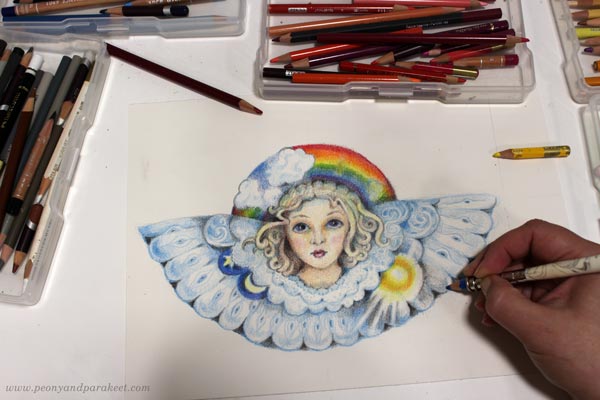
And when I handed the angel to her, she was thrilled to have her in the collection.

It feels that if I don’t cut the picture, it’s not ready for play!
Going Detailed with Colored Pencils
It has taken time to find colored pencil techniques to achieve similarly detailed touch like in Animal Inkdom and Magical Inkdom.
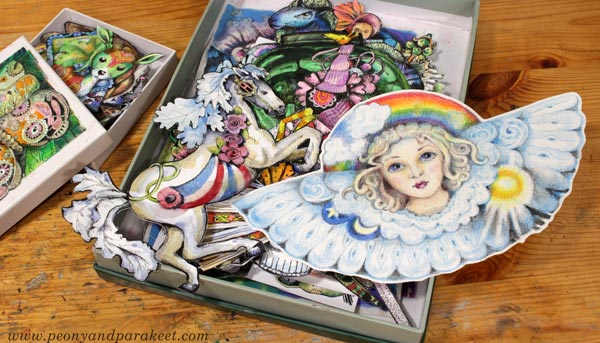
Making small pieces with colored pencils is more challenging than with ink pens, but maybe it doesn’t matter. I remember having a huge paper doll as a child. So, I could go larger without disappointing the inner child!

What would you like to create for your inner child?
Butterfly Art and Beyond
This week, I have some butterfly art, stories from the past, and plenty of inspiration for art-making.

Here’s the newest spread of my colored pencil journal. I think it’s a little different than the pages so far – more detailed at least! You can see most of the previous spreads in this video; tell me what you think!
With this butterfly fantasy, I want to take you more than a hundred years back in time – to the end of the 19th century when a famous Finnish artist Helene Schjerfbeck (1862-1946) painted Violets in a Japanese Vase in 1890.

Although Helene wasn’t as famous back then, she had traveled and studied abroad. And now, she had just got back home after spending a year in Paris and England. After painting people, Helene was now drawn to make nature-themed pieces. It felt refreshing to change big and challenging portraits to small landscapes and still lives. Flowers became Helene’s consolation pieces. When she was sent to St. Petersburg to copy Russian masterpieces and thus bring educational reproductions to Finland (“here’s how the masters paint”), she painted flowers for her own joy in the evenings. (See Helene Schjerbeck’s later style and my adaptation for colored pencils in this blog post!)
I can relate to Helene. My main work is big oil paintings – abstract florals or landscapes – but I also make art that soothes and maintains rather than breaks through. While the first pieces of the new series are drying and waiting for their next layers, I feel drawn to the boxes of pencils.
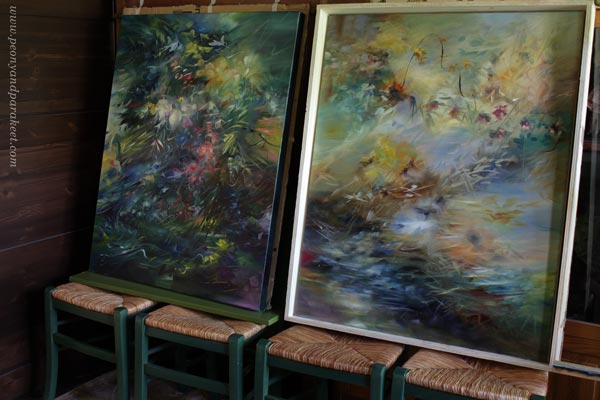
At the beginning of the week, after painting the whole Sunday, I wanted to draw something just for me. “Butterflies!” my inner child asked.
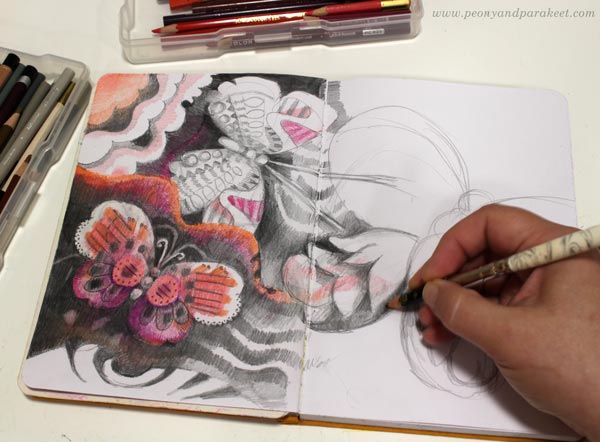
Here’s how far I got in one evening. This was before I traveled back in time to meet Helene – and another artist called Torsten Wasastjerna!
Fantasy Art in Villa Gyllenberg
In the middle of the week, my husband and I visited Villa Gyllenberg in Helsinki. It’s a museum that used to be the home of Signe and Ane Gyllenberg in the 20th century. The house was built in 1938, and it has a wonderful location near the sea.
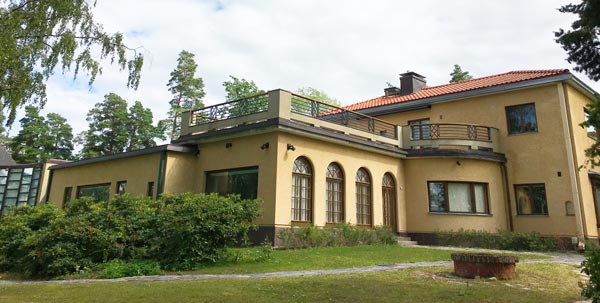
A part of the museum is a furnished old home with an extensive art collection, including Helene Schjerfbeck’s violet painting.

Just recently, Villa Gyllenberg got a new extension for art exhibitions. The new space has high walls and plenty of space, but still, there was something too big to fit there straight!
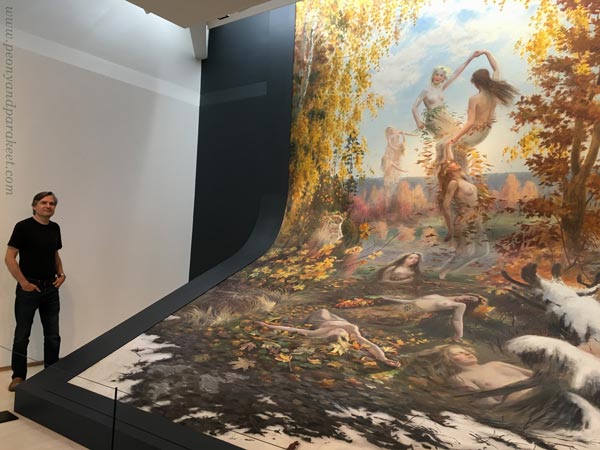
This is Torsten Wasastjerna’s oil painting Falling Leaves, made in 1897. It’s 550 cm high and 370 cm wide, one of the biggest Finnish paintings ever. My husband agreed to model beside it so that you get an idea of how big it is.
Inspired by Torsten Wasastjerna
Like Helene Schjerbeck, Torsten Wasastjerna (1863-1924) got an education in fine art and studied abroad too. But his consolation was fantasy. He did commission portraits to pay the bills but loved illustrating fairies and angels. He even wrote books. The first one was called Dröm och Värklighet – Dream and Reality.
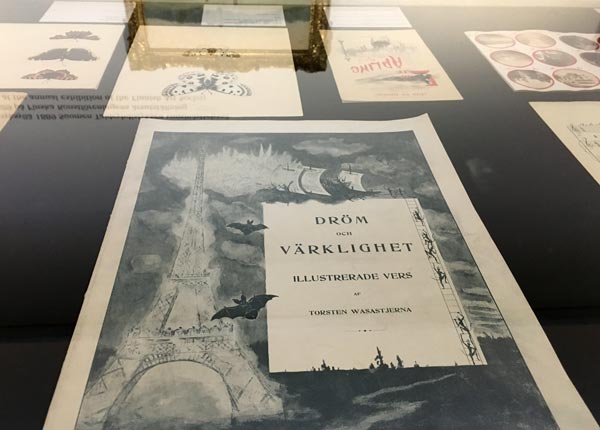
Torsten Wasastjerna’s fantasy world wasn’t as surreal as mine, but it felt close.
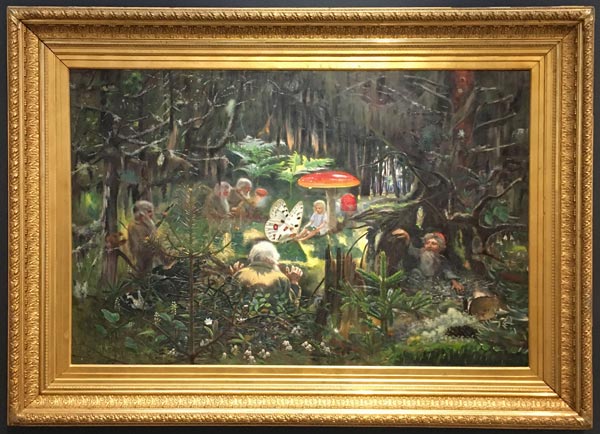
When I got back home, I was inspired to work on the butterfly piece with much more detail than I first had planned.

I added a person, a butterfly girl or a boy, to one of the wings.
Butterfly Art and Beyond
I am impressed by how dedicated Torsten was to his fantasy art, even if it was not valued by others.
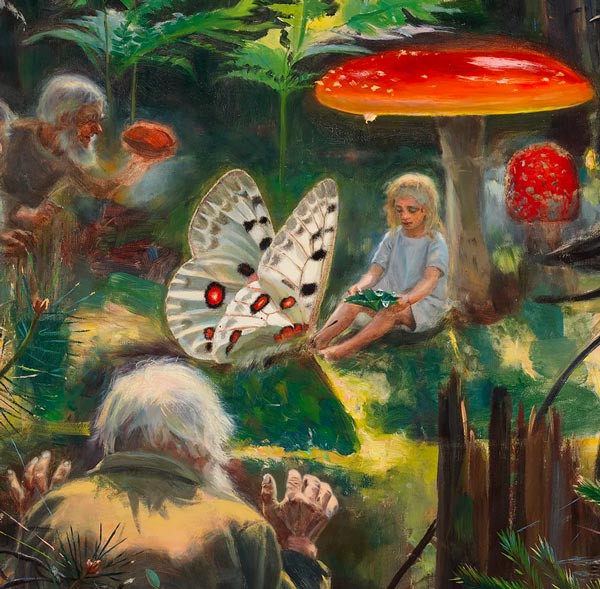
It made me think that I, too, can create “butterfly art” that goes beyond the butterflies – that challenges both my imagination and dedication.
So, I spent more hours than normally with this spread, adding details and then adjusting their shapes and colors.
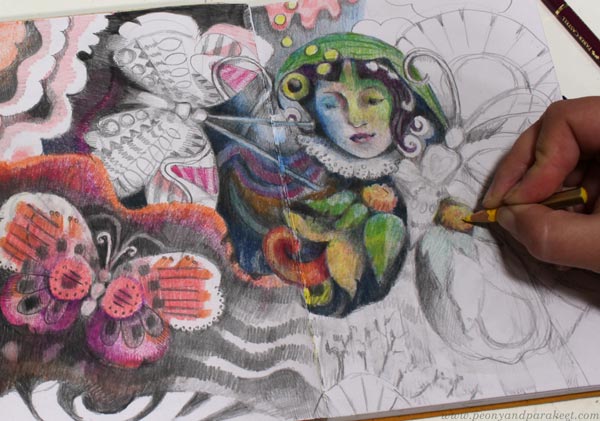
It felt like my pencils reached a new level, getting closer to my heart than before.
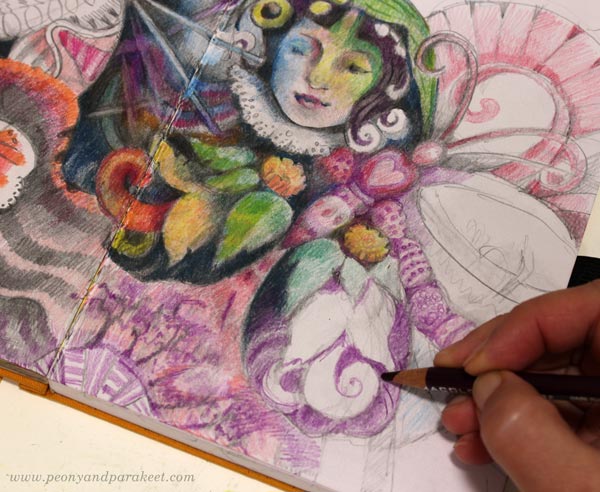
The world that is naturally and effortlessly born in my paintings fed the more illustrative work too.

All this makes me think about how important it is to go to see art and use that for inner discussions: how am I different, what are my consolation pieces, and how do I show my dedication to art? Then butterfly art can go beyond butterflies in the same way as Helene’s violets are not just “violet art.”
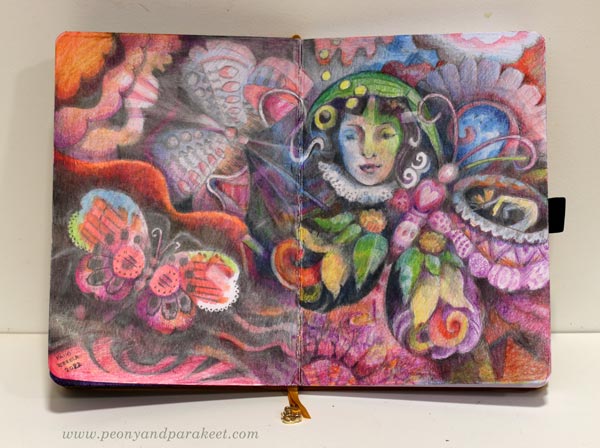
What do you think?